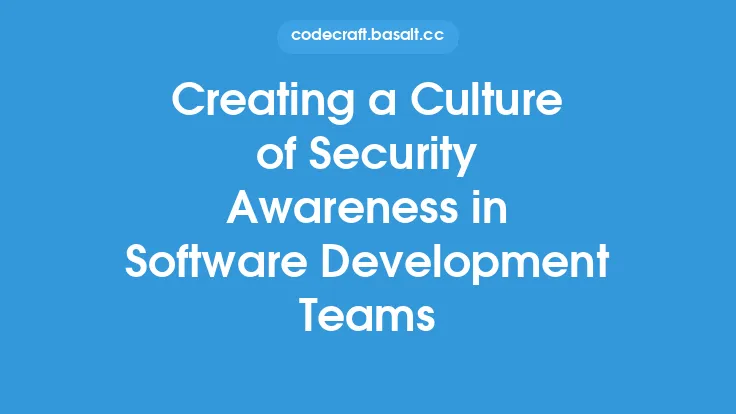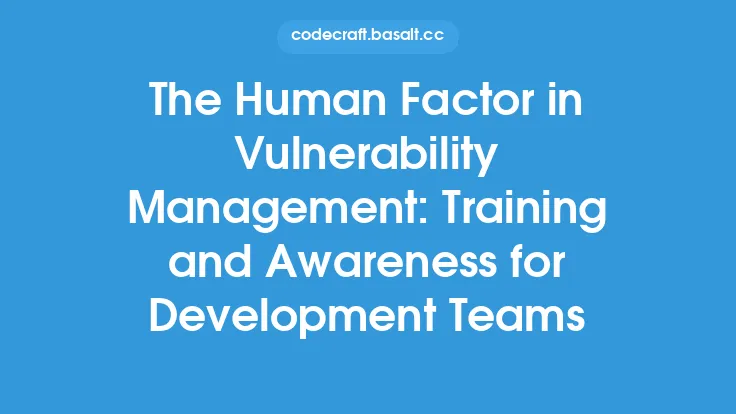Security awareness is a critical component of any software development organization's cybersecurity strategy. As software development teams continue to push the boundaries of innovation and technology, they also increase the attack surface of their organizations. Cyber attackers are constantly evolving their tactics, techniques, and procedures (TTPs) to exploit vulnerabilities in software applications, making it essential for software development organizations to prioritize security awareness.
Understanding the Threat Landscape
The threat landscape for software development organizations is complex and ever-evolving. Cyber attackers use various techniques to exploit vulnerabilities in software applications, including SQL injection, cross-site scripting (XSS), and buffer overflow attacks. Additionally, social engineering attacks, such as phishing and pretexting, are commonly used to trick developers into divulging sensitive information or gaining access to sensitive systems. To combat these threats, software development organizations must implement effective security awareness strategies that educate developers on the latest threats and vulnerabilities.
Security Awareness Training for Developers
Security awareness training is a critical component of any software development organization's security awareness strategy. This training should be designed to educate developers on the latest threats and vulnerabilities, as well as provide them with the knowledge and skills necessary to identify and mitigate potential security risks. Security awareness training for developers should include topics such as secure coding practices, threat modeling, and vulnerability management. Additionally, training should be interactive and engaging, using real-world examples and scenarios to illustrate key concepts and principles.
Integrating Security into the Development Lifecycle
Integrating security into the development lifecycle is essential for ensuring that software applications are secure and resilient. This can be achieved by implementing security-focused development methodologies, such as secure agile or DevSecOps. These methodologies prioritize security throughout the development lifecycle, from requirements gathering to deployment. Additionally, software development organizations should implement automated security testing and vulnerability management tools to identify and remediate potential security risks.
Creating a Security-Aware Culture
Creating a security-aware culture is critical for ensuring that security awareness is prioritized throughout the organization. This can be achieved by promoting a culture of security awareness, where developers feel empowered to report potential security risks and vulnerabilities. Software development organizations should also recognize and reward developers who prioritize security and identify potential security risks. Additionally, organizations should establish clear security policies and procedures, providing developers with the guidance and support they need to prioritize security.
Technical Security Controls
Technical security controls are essential for preventing and detecting cyber attacks. Software development organizations should implement a range of technical security controls, including firewalls, intrusion detection and prevention systems, and encryption technologies. Additionally, organizations should implement secure coding practices, such as input validation and error handling, to prevent common web application vulnerabilities. Technical security controls should be regularly reviewed and updated to ensure they remain effective against evolving cyber threats.
Incident Response and Management
Incident response and management are critical components of any software development organization's security awareness strategy. In the event of a security incident, organizations should have a clear incident response plan in place, outlining the steps necessary to respond to and contain the incident. This plan should include procedures for incident detection, containment, eradication, recovery, and post-incident activities. Additionally, organizations should establish an incident response team, comprising developers, security professionals, and other stakeholders, to respond to and manage security incidents.
Continuous Monitoring and Improvement
Continuous monitoring and improvement are essential for ensuring that security awareness strategies remain effective over time. Software development organizations should regularly review and update their security awareness strategies, incorporating new threats, vulnerabilities, and technologies. Additionally, organizations should continuously monitor their security posture, using metrics and key performance indicators (KPIs) to measure the effectiveness of their security awareness strategies. This information should be used to inform and improve security awareness training, technical security controls, and incident response and management procedures.
Security Awareness Metrics and KPIs
Security awareness metrics and KPIs are essential for measuring the effectiveness of security awareness strategies. Software development organizations should establish clear metrics and KPIs, such as the number of security incidents, the time taken to respond to incidents, and the number of developers who have completed security awareness training. These metrics and KPIs should be regularly reviewed and updated, providing organizations with the information they need to inform and improve their security awareness strategies.
Conclusion
In conclusion, effective security awareness strategies are critical for software development organizations, providing them with the knowledge and skills necessary to identify and mitigate potential security risks. By understanding the threat landscape, providing security awareness training for developers, integrating security into the development lifecycle, creating a security-aware culture, implementing technical security controls, establishing incident response and management procedures, and continuously monitoring and improving security awareness strategies, software development organizations can prioritize security and protect themselves against evolving cyber threats.





